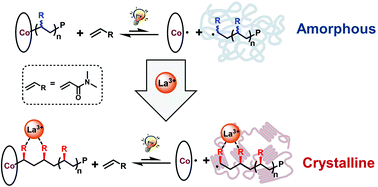Tacticity control approached by visible-light induced organocobalt-mediated radical polymerization: the synthesis of crystalline poly(N,N-dimethylacrylamide) with high isotacticity†
Abstract
The stereospecific living/controlled radical polymerization of N,N-dimethylacrylamide was achieved by the mediation of a macromolecular organocobalt complex in the presence of lanthanum triflate with visible-light irradiation. The stereo-controlled polymers showed high isotacticities with well-controlled molecular weights and low polydispersities. The contents of meso dyads (m) and meso triads (mm) could be raised to 94% and 87%, respectively. Most importantly, the noncrystalline poly(N,N-dimethylacrylamide) could be converted to a crystalline polymer, when the contents of m and mm were larger than 88% and 78%, respectively. With the increase of isotacticity, the crystallization process was changed from cold crystallization to melt crystallization. Meanwhile, the temperatures of crystallization and melting, as well as their enthalpies were all increased. After annealing treatment, relatively sharp signals were observed in powder X-ray diffraction. This is the first time that a crystalline polymer with high isotacticity, controlled molecular weight, and narrow polydispersity has been synthesized via radical polymerization.



 Please wait while we load your content...
Please wait while we load your content...